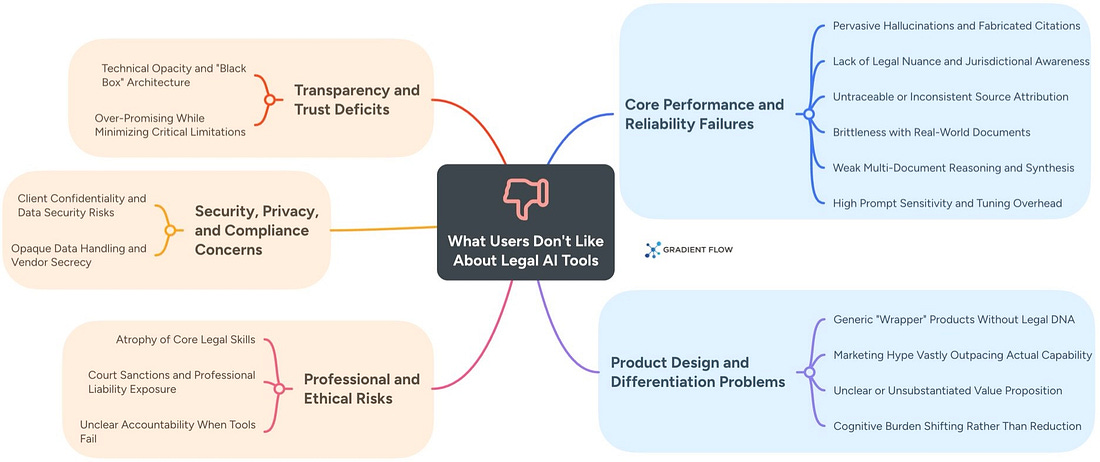|
Legal AI Unpacked: What Works, What Fails, What’s Next
Law firms were early adopters of tools for searching and classifying large document collections, so their current enthusiasm for generative AI follows a familiar pattern. Business press coverage reinforces this interest: articles forecasting the disruption of knowledge work routinely single out legal services as particularly vulnerable to automation, given the profession’s reliance on text-intensive research, drafting, and document analysis.
The view from online forums is much more guarded. Today’s tools still miss basic requirements for high-stakes work: they invent citations, blur jurisdictional boundaries, and falter on messy, real-world documents. Most Legal AI products are nothing more than thin layers over general-purpose models, with limited legal tuning, opaque behavior, and weak audit trails. Integration with older systems is brittle, confidentiality constraints are strict, and reliability is uneven. The prevailing pattern is cautious use for drafting, summarizing, and triage — always with human verification.
This tension between potential and peril makes the legal industry an interesting case study. While today’s foundation models are far from perfect, their adoption in legal settings offers a preview of how other high-stakes professions will grapple with the technology’s limitations. What follows maps the current landscape: where generative AI is gaining traction in legal practice today, the points at which it fails, and the engineering and governance work required to close the gap between prototype and production. For any leader considering AI’s role in knowledge work, the legal field provides an indispensable, if cautionary, guide.
Where Legal AI Works Today
Document Review & Analysis
Each of the following address a distinct workflow: contract review happens before deals close, summarization turns lengthy records into readable briefs, and discovery sorts evidence during litigation.
Contract Review and Risk Analysis. Law firms deploy generative AI to parse contracts, classify clauses (indemnity, termination, change-of-control), extract obligations, spot departures from standard terms, and assign risk scores. Roughly 28% of in-house teams rank this as AI’s highest-value application.
Where it breaks. Foundation models struggle with legal subtlety. Error rates climb on unusual deals and non-U.S. agreements. Poor formatting trips the systems. The real hazard is overconfidence: models generate plausible but incorrect clauses. Without legal grounding and rigorous checks, speed gains turn into liability exposure.
What’s next. Developers are building hybrid systems — LLMs anchored to legal knowledge graphs, retrieval methods tied to jurisdiction-specific sources, and independent citation checks. Emerging “agent” workflows chain tasks like intake, clause comparison, and exception reports, all with audit logs. Priorities include training on European, UK, and Asia-Pacific templates.
Legal Document Summarization. Generative AI compresses depositions, hearing transcripts, evidence files, and regulatory submissions into short summaries. Adoption is broad: 61% of practitioners now use AI for case-law summaries.
Where it breaks. Smooth prose can hide factual mistakes. Models lose context, omit critical details, or inject small errors that resurface later. Quality hinges on precise prompts, and even strong output requires verification. Summaries can also strip out cues that matter at trial — hesitation, evasive answers, tone — making them useful for initial review, not final work product.
What’s next. Tools are moving from single-document notes to multi-file synthesis across entire case records. Expect RAG pipelines with inline citations and visible reasoning chains as baseline features. Future versions will incorporate metadata — audio tempo, objection frequency — to retain nuance in deposition digests.
Discovery Document Tagging and Classification. In electronic discovery, generative AI labels documents for relevance, privilege (attorney-client or confidential), and case themes, interpreting context beyond keyword matching. Current adoption stands at 37%, with 56% planning use. Active users save one to five hours weekly; one litigation team cut first-pass review time when combining AI with human oversight.
Where it breaks. Errors carry litigation risk. Missing key documents can draw court sanctions. To be defensible in court, workflows need clear audit trails and transparent methods.
What’s next. Best practices are converging on a hybrid model: lightweight classifiers, RAG-backed explanations, and targeted human spot-checks, with every decision logged. New tools will build case timelines and narratives directly from tagged evidence. As courts issue guidance on AI-assisted discovery over the next two years, processes should standardize and adoption accelerate.
 |
Document Drafting & Generation
Litigation correspondence handles adversarial communications; contract drafting serves commercial transactions; medical chronologies solve a document-processing bottleneck specific to personal injury cases.
Demand Letter and Legal Correspondence Drafting. Law firms now use AI to generate demand letters — pre-litigation settlement proposals — along with court complaints and client emails. GPT-4-class models produce usable first drafts in minutes by pulling from case facts and firm templates. EvenUp and similar vendors embed automated quality checks.
